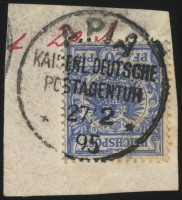Apia Cash Payment Frankings
During four periods from 1889 to 1895, the Apia post office was without postage stamps and had to resort to a cash franking procedure to note the proper payment of postage. These procedures consisted of a handwritten notation of the payment amount and an application of the Apia postmark. In several of the instances, postage stamps were later attached and cancelled, but the initial cash payment can still be ascertained by the handwritten notation and the known dates on which the correct postage was later applied and cancelled.
On 8 January 1889, the German Post Office in Apia burned down, destroying the stocks of postage stamps and all the postal equipment. The postal agent had a local printer make two cancels, one in German and one in English. For a period of several months, the German-language provisional cancel was used on cash payment frankings for mail without stamps, and, for stamps sold prior to the fire, as legitimate postmarks on Vorläufer stamps (see Apia postmarks page for usage of this postmark on stamped mail). The English-language provisional postmark is not known to have been used on cash payment frankings.
Postmark Information
Catalog:
- Friedemann BF 1
- ArGe Kolonien BEZAHLT Kaiserl. Deutsche Postagentur Apia ◆4
Dates of Use:
- 1 February 1889 to 2 April 1889
Notes:
- Used on items to German destinations
- 15 cash payment frankings with this postmark are known, with 1 on cover alongside only known use of the English-language provisional postmark on a cash payment franking
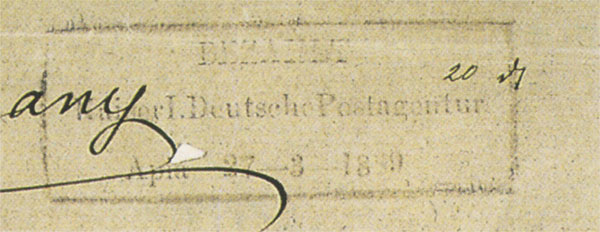
Postmark Information
Catalog:
- Friedemann BF 2
- ArGe Kolonien POSTAGE PAID Imperial German Postoffice Apia ◆5
Date of Use:
- 1 February 1889
Notes:
- 1 cash payment frankings with this postmark (undated) is known, alongside German-language provisional postmark dated 1 February 1889
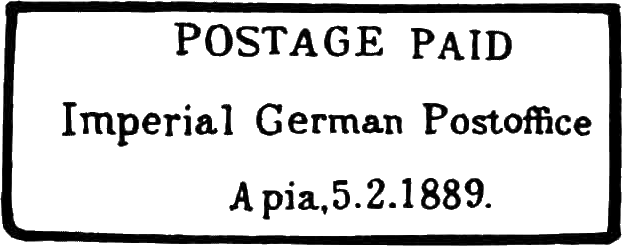
In December 1892, several vessels of the German East Asia Squadron visited Samoa. The volume of mail sent by the sailors depleted Apia’s stock of postage stamps, leading to the second period in which a cash franking procedure was used. The frankings consist of manuscript notations of the amount paid and the APIA KDPAg ◆6 postmark.
The Apia postmaster included the cash amount paid in the letter bag. The three covers to Europe (one to Sweden and two to Germany) were then franked with German stamps upon arrival at the first German post office, that of the Cologne-Verviers Railway – COLN (RHEIN)- VERVIERS BAHNPOST.
The fourth item was sent to Australia. Due to the fact that it was not being sent through a German postal system, the manuscript notation is “Postage Paid” instead of the monetary amount paid.
Postmark Information
Catalog:
- Friedemann BF 3
- ArGe Kolonien Unlisted
Dates of Use:
- 1 February 1893 to 1 March 1893
Notes:
- 4 items with this cash payment franking are currently known

In July 1894, the Apia post office again ran out of postage stamps. The reason for this shortage is unknown.
The cash payment frankings from this period also consist of manuscript notations of the amount paid and the APIA KDPAg ◆6 postmark.
Four items from this period are known. Two received subsequent postage and cancellations upon arrival in Germany. One received no additional postage as it was addressed to New Zealand. The fourth item is on piece and contains a marking indicating 15 Pf was paid, but also 15 Pf of postage cancelled in Apia on the same date as the notation. The circumstances that led to this combination are unclear.
Postmark Information
Catalog:
- Friedemann Unlisted
- ArGe Kolonien Unlisted
Dates of Use:
- 18 July 1894 to 9 August 1894
Notes:
- 4 items with this cash payment franking are currently known
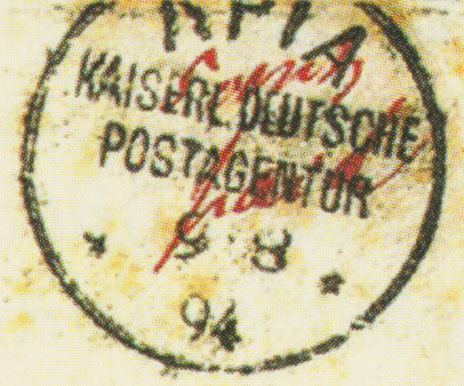
In December 1894, the Apia post office again ran out of postage stamps. The reason for this shortage is unknown, but is believed to be because of a failure of the postmaster to order stamps from Germany in a timely manner.
The cash payment frankings from this period also consist of manuscript notations of the amount paid and the APIA KDPAg ◆6 postmark.
Approximately 30 items from this period are known. They can generally be divided into three separate shipments of mail to Germany, dated 5 December 1894, 2 January 1895, and 30 January 1895; and 1 shipment to Jaluit on 14 January 1895. However, shipment of the items postmarked 30 January 1895 was delayed, and in the interim, additional postage arrived. Therefore, in addition to the manuscript cash payment franking and 30 January 1895 postmark on these items, they bear stamps with an Apia postmark of 27 February 1895.
Postmark Information
Catalog:
- Friedemann BF 4 I
- ArGe Kolonien Unlisted
Date of Use:
- 5 December 1894
Notes:
- 13 items with this cash payment franking are currently known
- 12 of the 13 transited Germany, receiving postage and postmarks from Bremen on 6 January 1895
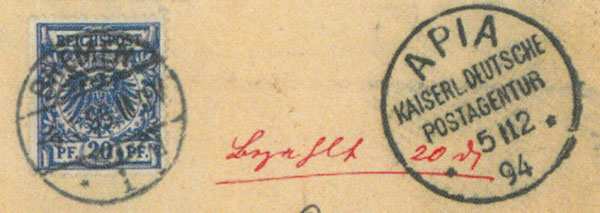
Postmark Information
Catalog:
- Friedemann BF 4 II
- ArGe Kolonien Unlisted
Date of Use:
- 2 January 1895
Notes:
- Approximately 5 items with this cash payment franking are currently known
- 3 of the 5 received subsequent postage and cancellation on the Cöln-Verviers Railway in Germany; 1 received subsequent postage and cancellation in San Francisco; 1 received no additional postage upon arrival in Jaluit
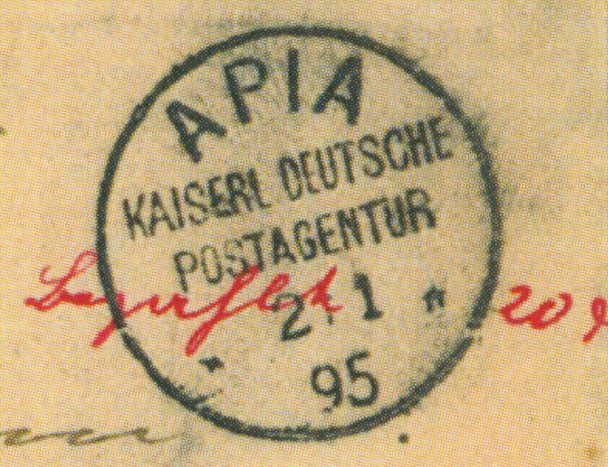
Postmark Information
Catalog:
- Friedemann Unlisted
- ArGe Kolonien Unlisted
Date of Use:
- 14 January 1895
Notes:
- 1 item with this cash payment franking is currently known, addressed to Jaluit
Postmark Information
Catalog:
- Friedemann BF 4 III
- ArGe Kolonien Unlisted
Dates of Use:
- 30 January 1895 / 27 February 1895
Notes:
- Approximately 10 items with this cash payment franking are currently known
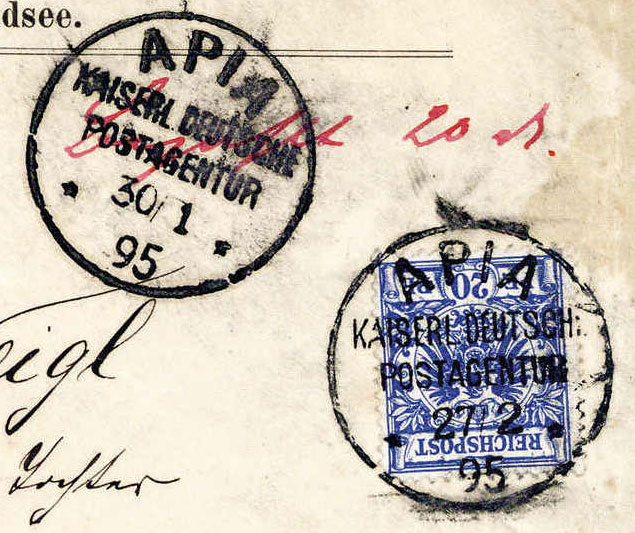
Apia Cash Payment Frankings
During four periods from 1889 to 1895, the Apia post office was without postage stamps and had to resort to a cash franking procedure to note the proper payment of postage. These procedures consisted of a handwritten notation of the payment amount and an application of the Apia postmark. In several of the instances, postage stamps were later attached and cancelled, but the initial cash payment can still be ascertained by the handwritten notation and the known dates on which the correct postage was later applied and cancelled.
On 8 January 1889, the German Post Office in Apia burned down, destroying the stocks of postage stamps and all the postal equipment. The postal agent had a local printer make two cancels, one in German and one in English. For a period of several months, the German-language provisional cancel was used on cash payment frankings for mail without stamps, and, for stamps sold prior to the fire, as legitimate postmarks on Vorläufer stamps (see Apia postmarks page for usage of this postmark on stamped mail). The English-language provisional postmark is not known to have been used on cash payment frankings.

Postmark Information
Catalog:
- Friedemann BF 1
- ArGe Kolonien BEZAHLT Kaiserl. Deutsche Postagentur Apia ◆4
Dates of Use:
- 1 February 1889 to 2 April 1889
Notes:
- Used on items to German destinations
- 15 cash payment frankings with this postmark are known, with 1 on cover alongside only known use of the English-language provisional postmark on a cash payment franking

Postmark Information
Catalog:
- Friedemann BF 2
- ArGe Kolonien POSTAGE PAID Imperial German Postoffice Apia ◆5
Date of Use:
- 1 February 1889
Notes:
- 1 cash payment frankings with this postmark (undated) is known, alongside German-language provisional postmark dated 1 February 1889
In December 1892, several vessels of the German East Asia Squadron visited Samoa. The volume of mail sent by the sailors depleted Apia’s stock of postage stamps, leading to the second period in which a cash franking procedure was used. The frankings consist of manuscript notations of the amount paid and the APIA KDPAg ◆6 postmark.
The Apia postmaster included the cash amount paid in the letter bag. The three covers to Europe (one to Sweden and two to Germany) were then franked with German stamps upon arrival at the first German post office, that of the Cologne-Verviers Railway – COLN (RHEIN)- VERVIERS BAHNPOST.
The fourth item was sent to Australia. Due to the fact that it was not being sent through a German postal system, the manuscript notation is “Postage Paid” instead of the monetary amount paid.

Postmark Information
Catalog:
- Friedemann BF 3
- ArGe Kolonien Unlisted
Dates of Use:
- 1 February 1893 to 1 March 1893
Notes:
- 4 items with this cash payment franking are currently known
In July 1894, the Apia post office again ran out of postage stamps. The reason for this shortage is unknown.
The cash payment frankings from this period also consist of manuscript notations of the amount paid and the APIA KDPAg ◆6 postmark.
Four items from this period are known. Two received subsequent postage and cancellations upon arrival in Germany. One received no additional postage as it was addressed to New Zealand. The fourth item is on piece and contains a marking indicating 15 Pf was paid, but also 15 Pf of postage cancelled in Apia on the same date as the notation. The circumstances that led to this combination are unclear.

Postmark Information
Catalog:
- Friedemann Unlisted
- ArGe Kolonien Unlisted
Dates of Use:
- 18 July 1894 to 9 August 1894
Notes:
- 4 items with this cash payment franking are currently known
In December 1894, the Apia post office again ran out of postage stamps. The reason for this shortage is unknown, but is believed to be because of a failure of the postmaster to order stamps from Germany in a timely manner.
The cash payment frankings from this period also consist of manuscript notations of the amount paid and the APIA KDPAg ◆6 postmark.
Approximately 30 items from this period are known. They can generally be divided into three separate shipments of mail to Germany, dated 5 December 1894, 2 January 1895, and 30 January 1895; and 1 shipment to Jaluit on 14 January 1895. However, shipment of the items postmarked 30 January 1895 was delayed, and in the interim, additional postage arrived. Therefore, in addition to the manuscript cash payment franking and 30 January 1895 postmark on these items, they bear stamps with an Apia postmark of 27 February 1895.
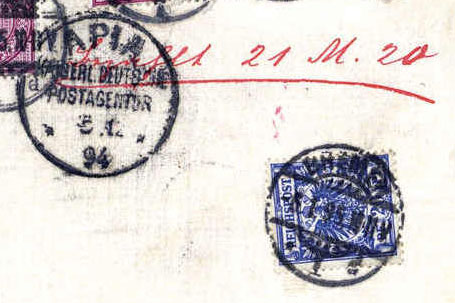
Postmark Information
Catalog:
- Friedemann BF 4 I
- ArGe Kolonien Unlisted
Date of Use:
- 5 December 1894
Notes:
- 13 items with this cash payment franking are currently known
- 12 of the 13 transited Germany, receiving postage and postmarks from Bremen on 6 January 1895

Postmark Information
Catalog:
- Friedemann BF 4 II
- ArGe Kolonien Unlisted
Date of Use:
- 2 January 1895
Notes:
- Approximately 5 items with this cash payment franking are currently known
- 3 of the 5 received subsequent postage and cancellation on the Cöln-Verviers Railway in Germany; 1 received subsequent postage and cancellation in San Francisco; 1 received no additional postage upon arrival in Jaluit
Postmark Information
Catalog:
- Friedemann Unlisted
- ArGe Kolonien Unlisted
Date of Use:
- 14 January 1895
Notes:
- 1 item with this cash payment franking is currently known, addressed to Jaluit

Postmark Information
Catalog:
- Friedemann BF 4 III
- ArGe Kolonien Unlisted
Dates of Use:
- 30 January 1895 / 27 February 1895
Notes:
- Approximately 10 items with this cash payment franking are currently known
Album Page(s)

